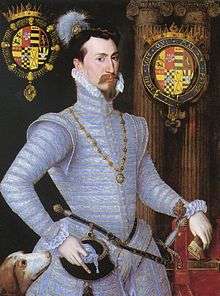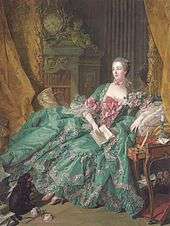Courtier

A courtier (/ˈkɔːrtiə/; French: [kuʁtje]) is a person who is often in attendance at the court of a king or other royal personage.[1] The earliest historical examples of courtiers were part of the retinues of rulers. Historically the court was the centre of government as well as the residence of the monarch, and the social and political life were often completely mixed together.
Description
Monarchs very often expected the more important nobles to spend much of the year in attendance on them at court. Not all courtiers were noble, as they included clergy, soldiers, clerks, secretaries, and agents and middlemen of all sorts with regular business at court. All those who held a court appointment could be called courtiers but not all courtiers held positions at court. Those personal favorites without business around the monarch, sometimes called the camarilla, were also considered courtiers. Promotion to important positions could be very rapid at court, and for the ambitious there was no better place to be. As social divisions became more rigid, a divide, barely present in Antiquity or the Middle Ages, opened between menial servants and other classes at court, although Alexandre Bontemps, the head valet de chambre of Louis XIV, was a late example of a "menial" who managed to establish his family in the nobility. The key commodities for a courtier were access and information, and a large court operated at many levels - many successful careers at court involved no direct contact with the monarch.
The largest and most famous European court was that of the Palace of Versailles at its peak, although the Forbidden City of Beijing was even larger and more isolated from national life. Very similar features marked the courts of all very large monarchies, whether in Delhi, Topkapı Palace in Istanbul, Ancient Rome, Byzantium, or the Caliphs of Baghdad or Cairo. Early medieval European courts frequently traveled from place to place following the monarch as he traveled. This was particularly the case in the early French court. But, the European nobility generally had independent power and was less controlled by the monarch until roughly the 18th century, which gave European court life a more complex flavour.
History
The earliest courtiers coincide with the development of definable courts beyond the rudimentary entourages or retinues of rulers. There were probably courtiers in the courts of the Akkadian Empire where we find evidence of court appointments like that of Cupbearer which was one of the earliest court appointments and remained a position at courts for thousands of years.[2] Two of the earliest titles referring to the general concept of a courtier were likely the ša rēsi and mazzāz pāni of the Neo-Assyrian Empire.[3]
The courts influenced by the court of the Neo-Assyrian Empire such as those of the Median Empire and the Achaemenid Empire had numerous courtiers [4][5] After invading the Achaemenid Empire Alexander the Great returned with the concept of the complex court featuring a variety of courtiers to the Kingdom of Macedonia and Hellenistic Greece.[6]
The imperial court of the Byzantine Empire at Constantinople would eventually contain at least a thousand courtiers.[7] The court's systems became prevalent in other courts such as those in the Balkan states, the Ottoman Empire, and Russia.[8] Byzantinism is a term that was coined for this spread of the Byzantine system in the 19th century.[9]
In literature
In modern literature, courtiers are often depicted as insincere, skilled at flattery and intrigue, ambitious and lacking regard for the national interest. More positive representations of the stereotype might include the role played by members of the court in the development of politeness and the arts.
In modern English, the term is often used metaphorically for contemporary political favourites or hangers-on.
Examples of famous courtiers in fiction
- Rosencrantz and Guildenstern from William Shakespeare's Hamlet
- Sir Lancelot from Arthurian legend
- Count Hasimir Fenring from Frank Herbert's Dune
- Gaius Helen Mohiam from Frank Herbert's Dune
- Petyr Baelish from George R. R. Martin's A Song of Ice and Fire
- Varys from George R. R. Martin's A Song of Ice and Fire
- Ivan Vorpatril from Lois Bujold's series Vorkosigan Saga.
- Sir Nicholas de Mimsy-Porpington from J. K. Rowling's series Harry Potter
Examples of famous British and French courtiers
- Anne Boleyn
- Alessandro Cagliostro
- John Dee
- Anne Hungerford
- Princess Marie Louise of Savoy
- The Dukes of Luynes
- Henri Coiffier de Ruzé, Marquis of Cinq-Mars
- Louis de Rouvroy, duc de Saint-Simon
- The Count of St. Germain
- Cardinal de Rohan
- Madame de Pompadour
- Walter Raleigh
- William Tallon
See also
- The Book of the Courtier, by Baldassare Castiglione
- Camarilla
- Courtesan
- Court appointment
- Éminence grise
- Favourite
- Royal mistress
- Sycophant
- Courtly love
References
- ↑ Courtier
- ↑ Radner, Karen (22 September 2011). The Oxford Handbook of Cuneiform Culture. Oxford, UK: Oxford University Press. pp. 358–379. ISBN 978-0-19-955730-1.
- ↑ Groß, Melanie; Pirngruber, Reinhard (September 2014). "On Courtiers in the Neo-Assyrian Empire: ša rēsi and mazzāz pāni" (PDF). Imperium and Officium Working Papers (IOWP). Retrieved 24 February 2015.
- ↑ Dandamayev, Muhammad. "COURTS AND COURTIERS i. In the Median and Achaemenid periods". Encyclopædia Iranica. Encyclopædia Iranica. Retrieved 24 February 2015.
- ↑ Maria Brosius (2007). Spawforth, A.J.S., ed. The Court and Court Society in Ancient Monarchies. Cambridge UK: Cambridge University Press. pp. 1–57. ISBN 978-0-521-87448-9.
- ↑ Tony Spawforth (2007). Spawforth, A.J.S., ed. The Court and Court Society in Ancient Monarchies. Cambridge UK: Cambridge University Press. pp. 93–97. ISBN 978-0-521-87448-9.
- ↑ Kazhdan, Alexander P.; McCormick, Michael (1995). "The Social World of the Byzantine Court" (PDF). In Maguire, Henry. Byzantine Court Culture from 829 to 1204. Harvard University Press. p. 175. ISBN 9780884023081.
- ↑ Angelov, Dimiter G. (2003). "Byzantinism: The Imaginary and Real Heritage of Byzantium in Southeastern Europe". New approaches to Balkan studies. Brassey's. pp. 3, 11. ISBN 1574887246.
- ↑ Angelov, Dimiter G. (2003). "Byzantinism: The Imaginary and Real Heritage of Byzantium in Southeastern Europe". New approaches to Balkan studies. Brassey's. p. 8. ISBN 1574887246.
External links
| Look up courtier in Wiktionary, the free dictionary. |
| Wikiquote has quotations related to: Courtiers |


